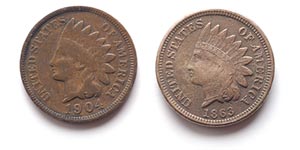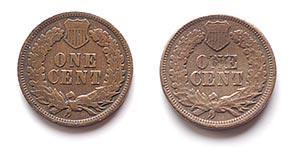 The 1859 reverse was also changed to represent a laurel wreath. In 1860 the reverse was modified to display an oak wreath with a small shield at the top. There are three varieties: the first type a Copper-nickel, Laurel Wreath Reverse (1859) Variety two: Copper-nickel, Oak Wreath w/shield (1860 to 1864) Variety three: Bronze 1864 - 1909 During the year 1864 the alloy of the cent was changed to 95% copper and 5% tin and zinc.
The 1859 reverse was also changed to represent a laurel wreath. In 1860 the reverse was modified to display an oak wreath with a small shield at the top. There are three varieties: the first type a Copper-nickel, Laurel Wreath Reverse (1859) Variety two: Copper-nickel, Oak Wreath w/shield (1860 to 1864) Variety three: Bronze 1864 - 1909 During the year 1864 the alloy of the cent was changed to 95% copper and 5% tin and zinc. The weight was reduced to 48 grains, resulting in a thinner coin than the so called white cents of 1856-1864. The design remained unchanged. Before 1864 cents did not have the designer's entitle L on the bonnet ribbon; late in that year the letter appeared on only a small quantity.
The weight was reduced to 48 grains, resulting in a thinner coin than the so called white cents of 1856-1864. The design remained unchanged. Before 1864 cents did not have the designer's entitle L on the bonnet ribbon; late in that year the letter appeared on only a small quantity.The initial appeared on all dates of Indian cents thereafter. L is the initial of the engraver, Longacre. Indian Heads were made from 1859 to 1913. The most valuable are the 1869 and 1872.
No comments:
Post a Comment